The popularity in popper fishing for giant trevally and other pelagics has soared in recent years, spurred on by the success and exploits of Nomad Charters and clued in anglers looking for one of the toughest battles you’ll encounter on the ocean.
Bommie brawlers like trevally have caught the attention and intrigue of many anglers across the country. Most dedicated fishers have seen the remarkable footage created by those from the Nomad Charter crew plus other anglers sampling the adrenalin rush at the extreme end of topwater fishing.
Last year, I managed to fulfil an angling dream when I took a trip aboard Nomad Charters to sample world class GT popping at Elusive and Bugatti reefs. Before departure, I did some research on rigging the large poppers and stickbaits, which I was taking to target these tough predators. I also learnt a lot from the guides while I was out there, seeing first hand the benefits in rigging these offerings in certain ways. Hopefully, what I’ve learnt may help other anglers planning a popping and stickbaiting trip.
The most important consideration when rigging any popper or stickbait is the requirement for quality, heavy-duty hardware.
Stoping 25-50kg of marauding trevally or dogtooth tuna from reaching the sanctuary of its reef refuge requires a huge amount of applied pressure, necessitating heavy drag settings. The force applied to every piece of tackle when your PE8 to PE10 popper rod is loaded solid dictates that there is no room for weak links.
More commonly used brands of hooks and rings have earned their popularity due to reliability. Owner, Decoy, Shout, Shogun and Maria produce hooks, split rings or Kevlar cord assist-hooks that are easily up to the task of tangling with the toughest GT and other pelagics including dogtooth tuna, Spanish mackerel and yellowfin tuna. Reef dwellers such as coral trout and gigantic cod are also worthy adversaries for the heavy popping gear.
Poppers and stickbaits must be exceptionally strong, with full-length, high-tensile wire throughout the tough wood or resin construction. While having 200-400kg wire running through the middle almost guarantees that you will stay connected to the solidly hooked fish, it won’t ensure that an inferior popper won’t be snapped in half due to the immense jaw pressure exerted when a large aggressive fish smashes the popper. For this reason, quality poppers and stickbaits last much longer than the cheaper models, providing you can wheel the hooked fish away from its sanctuary and get the popper safely back to the boat.
Naturally, hooks are an extremely important part of the whole equation. They are responsible for securing and holding the adversary when it strikes. Hooks need to be exceptionally sharp and extremely tough. Most keen anglers have veered away from using treble hooks on large poppers and stickbaits as they damage the fish and are also much more dangerous to humans during handling and release of the fish.
Single hooks offer a better purchase on the fish once set and are less likely to tear out. For this reason most anglers choose to use single hooks for rigging larger stickbaits and poppers. Most of the better quality poppers do not come with hooks and rings therefore you need to sort out their rigging yourself. Hooks which distort slightly are better than those that will simply snap under extreme pressure, however most of the hooks used for this extreme sport will rarely do either.
Some of the most reliable and commonly used hooks include Owner (Jobu, SJ-41, SJ-51), Shout (Kudako), Shogun (Assassin, Viper) and Decoy (Cutlass JS-2). Each possesses a different construction, metal finish, shank length and point. Some may suit certain rigging situations better than others, however all are exceptionally strong and up to the task.
Hooks can be used for many different applications in rigging poppers and stickbaits. Hooks can be attached in singles or twin hook configurations from the tail, front eyelet or towing point. The different shank lengths make some better for various applications and lure styles than others, however most serious anglers have their own views and preferences for different hook patterns.
Split rings, usually with breaking strains in excess of 100kg, are used to attach the hooks to the eyelets on the lures. Sometimes you need to link two together to get the hook to sit at the correct angle. Usually, the correct hook position is point up for the rear hook and point down for a single front hook. If using two hooks on the front eyelet then the points should protrude out to each side of the lure and be wider than the lure.
Sometimes a swivel may be added to the equation to lengthen the hook rig or decrease torsion on the towing eyelet and hooks. These need to be heavy-duty also, generally sporting breaking strains in excess of 200kg. These swivels and rings are also used for lure attachment to the leader.
The leader (usually 130-200lb monofilament) is knotted or crimped to the swivel. The split ring is then used to attach the swivel to the towing eyelet of the lure. Lures are then easily changed with good split ring pliers (Black Magic Large or Owner GP-60 are great) to wind the split ring off one lure and then re-attach it to another popper or stickbait.
Some of the trusted and more popular brands of split rings are Owner Hyper Wire (#9, #10, #11, #11H) and Decoy (#9, #10, #11). The eyelets of many hooks are quite thick so this has to be taken into consideration when choosing a ring.
If the ring has to be pried open excessively to get it over the thickness of the hook eyelet, it may not return to its original closed position, which can sacrifice the breaking strain. Therefore, larger split rings are generally required for thicker hooks.
Some hooks, such as the Owner Jobu have a thinned section in the eye of the hook, which was purposely put there to aid in this regard. This has not jeopardised the strength of the hook but makes putting on the split rings much easier.
Leaders are generally attached to the braided main line with knots such as the PR or FG, the latter I favour due to its simplicity and reliability.
There are many different schools of thought on the correct way to rig certain poppers.
Most experienced anglers have made conclusions from their experiences or from the general consensus of their peers.
The shape of different poppers often dictates what hook combination is likely to maximise hook-up rate. Different target species also play a part in your decision.
For example, large giant trevally have a tendency to hit a popper at the head, therefore many anglers, including myself, believe that head-hooks are a good rigging option. Basically a head-hook is a free-swinging hook that is attached to the towing eyelet of the lure with some form of cord.
Generally this is assist cord or 180kg (2mm) Spectra cord (available at most marine chandleries). Head-hooks are relatively easy to make yourself although can be purchased pre-assembled. Some readily available include Master Baiter Custom Tackle GT Head-Hook (with 7/0, 8/0 or 9/0 Owner Jobu), Maria Hyper Jig Hook (with 11/0 Owner SJ-41) and the Shout Power Assist (with Shout Jaco 5/0, 6/0, 7/0).
I was quickly convinced of the success of these popper head-hooks during my trip on Nomad and most of the fish I landed were hooked on this freely swinging hook. There is also less chance of the leader fouling with the hooks during an aggressive strike or when a popper cartwheels out of the water during a mistimed pop in choppy conditions.
With a head-hook the hook will easily fall free of the leader and you haven’t wasted the entire cast due to a fouled lure. Head-hooks are only used on poppers, as they will interfere with the swimming action of most stickbaits.
Hooks used for the rear of a popper or stickbait are a hotly debated topic amongst keen GT popping aficionados however I like the Owner Jobu when attached with a single split ring. If two rings are required due to the position of the rear eyelet, then the shorter Owner SJ-41 or Shogun Assassin are also excellent options for poppers and stickbaits. Maximum hook exposure is paramount for a high percentage of hook-ups, however the lure’s action must not be impeded by excessively large or heavy hooks.
I favour rigging all my large poppers with a Kevlar cord head-hook on the towing eyelet and a single hook on the rear eyelet. If not using a head hook then the next option would be for twin hooks on the front eyelet, nothing on the towing eyelet and a large single on the rear. These twin hooks are positioned on the split ring back to back.
A zippy tie or similar is used to hold them in this position, eliminating fouling during casting and maximising hook-up potential. The width between the two points should be at least 30% wider than the popper at this position to ensure the hook point is sitting proud of the lure.
When a fish hits the lure, tension will pull the lure from the fish’s initial grasp. If the twin hooks are wider than the lure that the fish is biting down on, there is a much greater chance that one or both points will find their mark. A large single could be used on this front eyelet however the twin hook rig offers better hook exposure.
Sometimes when using hooks with short shanks in your twin hook rig, an extra split ring and swivel is added to lengthen the rig and maximise hook exposure. This also decreases the torque on the hook eyelet and the chance of the hooks tearing out.
Many of the better quality poppers already have a swivel for this front towing eyelet (and sometimes the rear eyelet) for this reason. Most hooks can be used for twin hooks including Owner Jobu, Shogun Assassin plus Owner SJ-41 and SJ-51.
Rigging stickbaits is not that different from rigging poppers with the same hooks and rings put to use.
Head hooks do not work on stickbaits as these are worked with a fairly constant retrieve and therefore the head hook would hang to one side of the stickbait and interfere with the swimming action. For this same reason, a single hook does not work well on the front eyelet. Usually twin hooks or a treble are used.
I do not like trebles for this application and prefer twin hooks which offer better hook exposure. I also believe most stickbaits have a better action when rigged with twin hooks at the front.
For the rear, a single hook is generally the best choice with the Owner Jobu or Shogun Assassin my choice. As with poppers, twin hooks need to be a degree wider than the lure width for increased hook exposure and maximum hook-up potential.
I also like the rear hook to be wider (distance between the hook point and shank) than the stickbaits width from top to bottom, however this is sometimes not always possible. You do not want to impede the stickbaits action with an excessively large or heavy hook.
If the lure doesn’t swim well then you are less likely to get strikes and therefore the best hook exposure will not aid your cause. However, most poppers and stickbaits will generally not be impeded by heavy-duty hardware.
Poppers and stickbaits fished off heavy line for serious sportfish will require quality hardware to initially get you connected and keep you hooked up to that trophy specimen.
Trebles will work, however for a better result for all concerned, single hooks are the way to go. Maximising your hooking potential will mean more fish to the boat and less missed strikes. Quality lures, hooks and split rings are dictated by the immense pressures exerted during this extreme form of fishing. Different riggings for various poppers will allow lures to maintain their desired actions and heighten your chance of success.
A little bit of thought before you hit the water can go a long way. After this it is all up to your skill, the location and the aggressiveness of the fish. By the way, it may also be a good idea to hit the gym.
Reads: 7098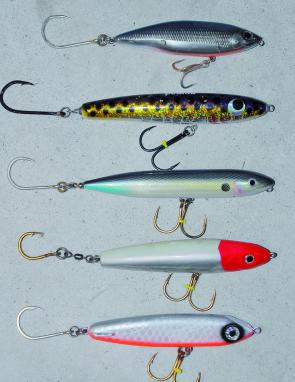
Some various ways to rig stickbaits.
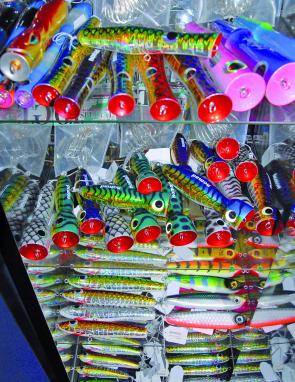
Most high quality stickbaits and poppers are sold without hooks and rings.
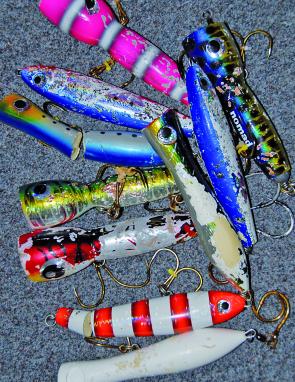
A selection of battle scarred and broken lures from a recent GT popping trip.
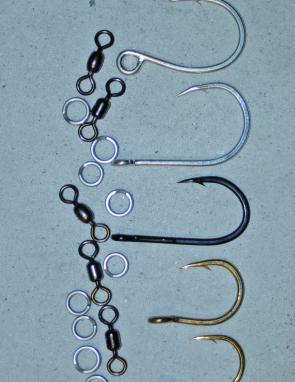
Quality rings and hooks are essential for rigging large poppers and stickbaits. Hooks are Owner SJ-41, OwnerSJ-51, Owner Jobu, Shogun Assassin and Shogun Viper.
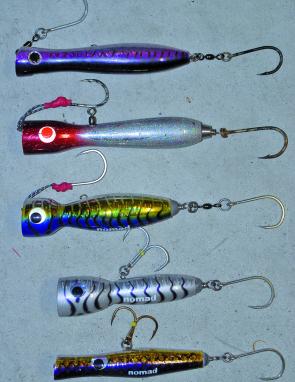
There are numerous ways to rig large poppers.
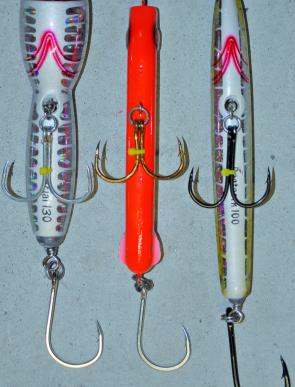
Belly hooks on stick baits and poppers should protrude at least 30% out each side of the lure.
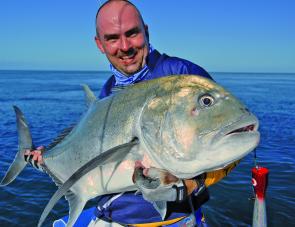
The end result of good rigging. A quality GT hooked on a head hook rigged popper.
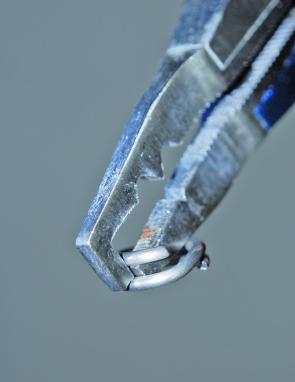
Quality split ring pliers like these from Black Magic make it simple to apply large split rings.
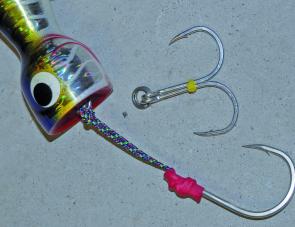
A completed head hook and a belly hook ready top go onto a large popper.




